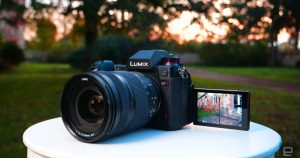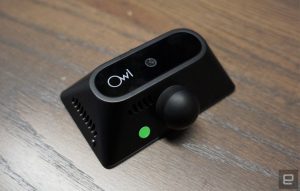The grip on the S1R is huge, bigger than on any other mirrorless camera, by far. That gave me confidence I’d never drop it, even in slippery or cold conditions. It’s also weather-sealed and certified to operate in temperatures from 14 to 104 degrees F, and I shot a lot of photos at around the latter temperature during a heatwave in Paris. While it certainly got hot, it never stopped working.
With the extra size, Panasonic was able to squeeze in tons of manual controls and I found pretty much everything, like the joystick, dials and ISO controls, to be in just the right place. I liked the fact that the focus and shooting controls were on dedicated buttons, rather than buried in menus. The only thing I didn’t care for was the placement and operation of the on/off switch, as it’s too hard to find by feel and too easy to accidentally bump.
The rear display can be tilted and flipped out, but unfortunately, it can’t be flipped around 180 degrees. Considering that the GH5/GH5s has a fully articulating screen, I frankly don’t see why the S1/S1R can’t have one, too. Even though it’s obviously not a vlogging camera (too heavy), it would still be a handy feature for solo videographers like myself.
On the plus side, that screen is touch-enabled, letting you select focus, Q-menu and main menu settings without buttons. I found Panasonic’s menus to be very logically grouped into categories and subcategories. Everything is also fully programmable, letting you tweak the camera to work just the way you want.
Panasonic’s electronic viewfinder (EVF) is superb, with excellent optics, a 5.76-million dot OLED display, 120 fps refresh rate and .005-seconds of lag. It’s sharp and accurate, which let me see quickly if focus and color temperatures were on point. This EVF (also found on Sony’s new A7R IV) pretty much destroys any remaining arguments for an optical viewfinder.
The big body houses Panasonic’s excellent 5-axis stabilization system. It delivers 6 stops of shake reduction, or 6.5 with dual IS if you have a supported, optically stabilized lens like the Lumix 24-105mm f/4.0 model. It yielded sharp photos down to an 1/8th of a second or less and video that was smooth when shot handheld, as long as I didn’t do anything too crazy, like a handheld tracking shot.
Panasonic beats Nikon’s Z 7 and the Canon EOS R with two card slots, one for SD UHS II and the other XQD. Working photographers can shoot to both cards at once for backup, and the fast, 440 MB/s XQD slots will be a boon for video shooters. Eventually, the S1R will support CFexpress cards, which will let you transfer media to your PC at up to 1,700 MB/s and save serious amounts of time.
Like the S1, the S1R has both headphone and microphone ports and will support professional XLR audio input/output via a dedicated hotshoe adapter. It’s got a USB Type C port for data transfers and charging, a full-sized HDMI port and support for Bluetooth/WiFi transfers and camera control. Camera apps generally suck, but the Lumix Sync app is actually pretty responsive and easy to setup and use.
Performance
Bucking the trend to hybrid phase- and contrast-detect autofocus, Panasonic has stuck with its advanced contrast-detect system that it calls “depth from defocus.” The idea is to maximize image quality by eliminating phase-detect pixels on the sensor, while still delivering consistent autofocus performance.
I was less than impressed with the contrast-detect AF on the S1, which tended to hunt or not lock on focus, particularly in low light and during burst and video shooting. The S1R seemed to perform better, however, possibly due to a recent firmware update.
Unlike phase-detect systems, which can lock onto focus directly, the S1R needs to hunt for focus (see an explanation here), which is distracting when you’re looking through the EVF. Luckily, I did get sharp images most of the time, even during continuous shooting, when using area, subject and tracking spot autofocus. The hit rate was lower in low-light conditions, but not unmanageably so.
The contrast detect AF is a plus for AI-powered face- and eye-detect AF systems, which don’t use phase-detect pixels. I found the S1R’s subject, face and eye-tracking systems fast and powerful, keeping my eyes, body and face locked under most circumstances. It also has an animal-detect system that tracked our dogs just fine, but was more confused by the chickens.
Panasonic has done amazing things with depth from defocus, but it’s still not as good as hybrid systems, particularly on Sony’s A7 cameras. It didn’t hit focus as consistently as the A7R III, particularly in burst shooting with continuous autofocus enabled. That said, the S1R is aimed at landscape, architectural and portrait photographers, and for those folks, the AF system is just fine.
With a new firmware release, Panasonic has boosted the stabilization system (IS) from 5.5 to 6 stops, or 6.5 stops with dual IS enabled. I found it worked extremely well, yielding sharp pictures at low shutter speeds, even after I drank several cups of coffee. Tellingly, I shot a number of photos in low-light, and some of the people in the shot were sharp while others (who moved) were blurred. That means the IS system did its job.
The S1R has a big 23Wh battery, but the big sensor, high-res EVF and image stabilization system take their toll. The S1R delivers just 380 shots per charge, compared to 530 for Sony’s A7R III and A7R IV. On the plus side, I was able to shoot video for about two hours before changing the battery, which is excellent for a full-frame camera.







